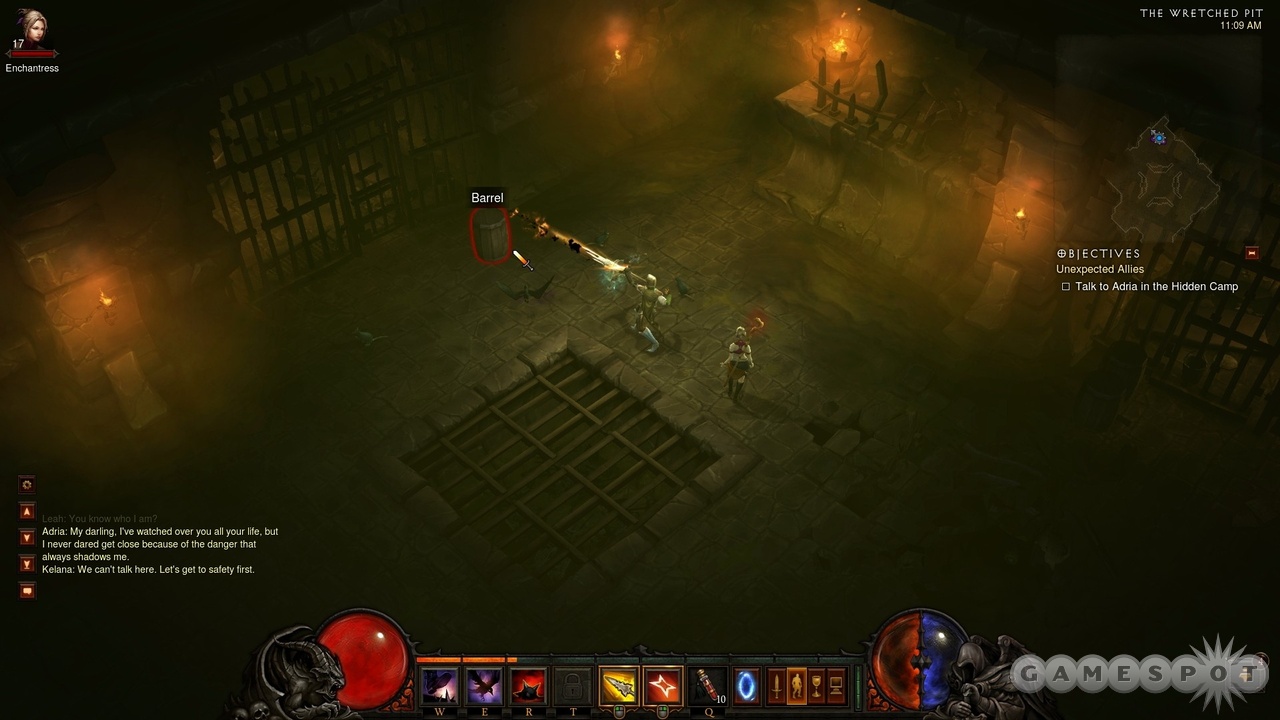Once upon a time, the Diablo series defined the hack-and-slash action role-playing game, setting the standard by which all games in the genre were measured. Now, Diablo III feels more familiar than genre-defining, relying on refining the same hooks that have always made this series so compelling. But what a refinement it is. The controls are responsive and pleasurable; the diversity of character classes and skill customization options is impressive; and the constant stream of gold and treasure you earn is irresistible. Blizzard has the recipe for crafting a habit-forming loot-driven action RPG down to a science, and in Diablo III, the results of that recipe are more exciting and more addictive than they've ever been.
You begin your quest just after what appears to be a flaming star falls from the heavens and crashes into the cathedral in Tristram, the doomed town where the events of Diablo took place. This cosmic occurrence has the unfortunate side effect of reanimating the dead, and the people of New Tristram find themselves besieged by corpses long ago put to rest. Diablo III's story is unremarkable, but it weaves in plenty of references to and appearances by characters from earlier games and enriches the established lore of the series. Fans of Diablo and Diablo II will immediately feel drawn into this world.
You certainly don't need any familiarity with the series to jump right into Diablo III, however. If you've played earlier games, you'll likely get even more out of Diablo III--the music that plays in the New Tristram area may send nostalgic shivers down your spine--but the gameplay is welcoming and easy to grasp for vets and newcomers alike. You choose one of five character classes, and though they become quite distinct at later levels, they all start with nothing but basic offensive skills that are performed with clicks of the mouse.
That may sound dull, but in fact the rate at which you acquire new skills is part of what makes Diablo III so hard to pull yourself away from. You very quickly open up slots for new types of abilities; if you're playing as a demon hunter, for instance, you begin with a basic archery attack, but you can soon supplement this with resource-draining skills like a rapid fire ability, enemy-slowing caltrops, acrobatic somersaults that can get you away from enemies, and other techniques.
These skills are divided into distinct categories--primary, secondary, defensive, and so on--and by default, you can have only one skill from each category equipped at a time. This is a sensible restriction if you're a novice player, because it helps ensure that your character is well rounded, with a complementary assortment of abilities. However, if you prefer a greater level of character customization, you can turn on what's called elective mode. With this on, you can opt to equip whichever skills you want in your available slots, rather than being limited to choosing one from each category. But if you do this, be mindful of your character's resource pool. If you select two monk skills that cost spirit (the monk's resource) and no skills that generate spirit, you're going to have some trouble slaughtering the legions of hell spawn you encounter.
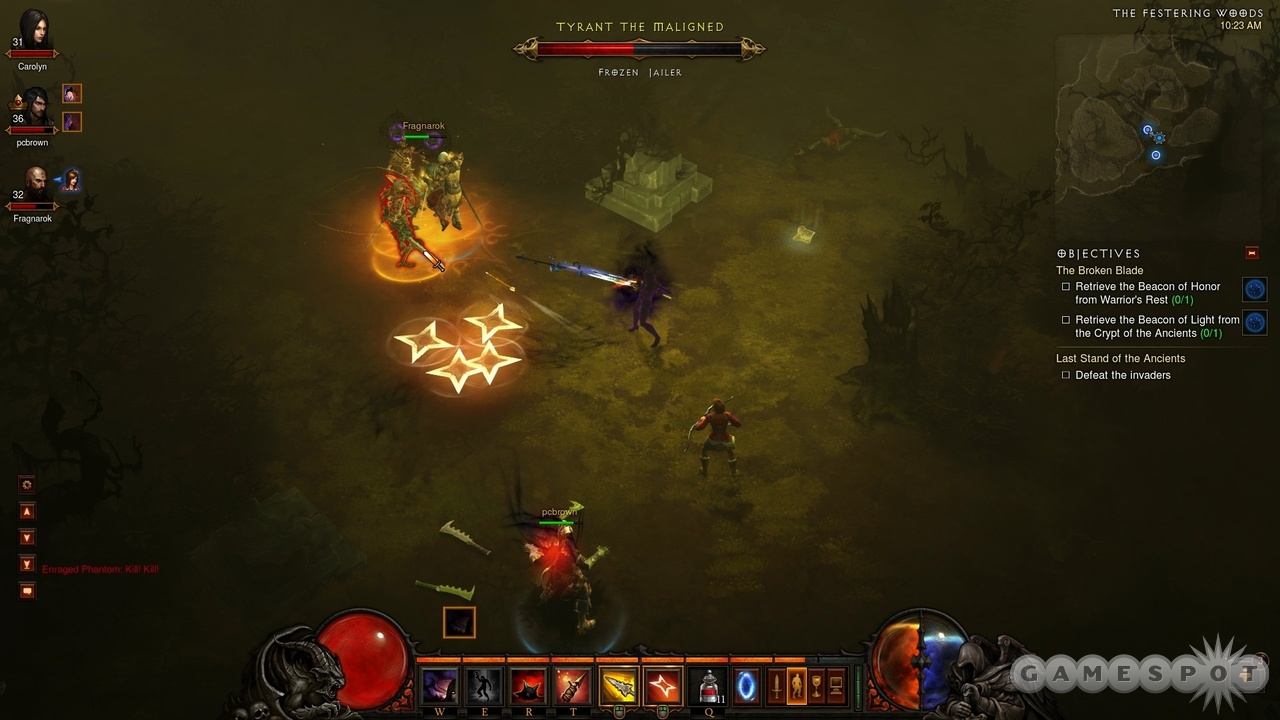
Choosing one skill always means not choosing another, since your number of available key bindings is always equal to the number of active skill categories you've unlocked. (Once you've unlocked all six skill categories for your class, for instance, you have just six bindings to which you can link skills.) But you can change your selected skills at any time, giving you free rein to tinker with your abilities until you find a combination you're happy with.
You never sink points into skills to make them more effective, so you never have to worry that you're not making the best choices. Rather, as you level up, you unlock both new skills and new runes you can apply to existing skills. From level 13 on, for instance, witch doctors can apply the numbing dart rune to their poison dart attack, which adds a slowing effect to this offensive ability. You can eventually unlock a total of six runes for each active ability, though you can have only one rune at a time activated on any ability. This system prevents you from squandering your character's growth by sinking points into skills that leave you ill-equipped for challenges to come, and lets you customize your abilities on the fly to better tackle the challenges you're currently facing.
It's not all about unlocking skills, however. It's about employing those skills to slaughter the monsters you encounter as you travel the world, and collecting the loot the fiends drop. This is where Diablo III's habit-forming pleasures lie. The randomly generated environments encourage exploration; you never know what treasure (or what powerful foe) you might find down each cathedral hallway or desert trail. Enticing art design draws you into these realms. In and around New Tristram, a foreboding mist hangs in the air, and ancient ruins crumble as you visit places long undisturbed. In the lands around the elegant city of Caldeum, you traverse stark landscapes of cracked earth and bone.
You explore ornate, musty manors and spider-infested caves. You make your way through rat-infested sewers and emerge into a dusky, teeming oasis. And though the inspiration it draws from The Lord of the Rings is a bit obvious, a setting in the game's fourth act effectively makes you feel like part of a desperate, large-scale war between humanity and the forces of hell. Just when you've had your fill of one region, it's time to move on to another, and each location is so different from the one that preceded it that you feel as if your quest to rid the land of evil is taking you across a vast and varied land.
As diverse as these locations are, they all have one thing in common: they're crawling with monsters. In the early stages of your quest, most monsters fall to your attacks without putting up much of a fight, though if you get swarmed, you might still need to keep an eye on your health. (Unlike in Diablo II, you can't spam health potions to immediately counter any damage you suffer; potions have a cooldown timer, requiring you to play a bit more cautiously.) Your attacks look mighty and effective, which makes the simple act of unleashing them feel empowering. The demon hunter's huge chakrams weave through the air, blades spinning; the barbarian's hard-hitting attacks can send foes flying.
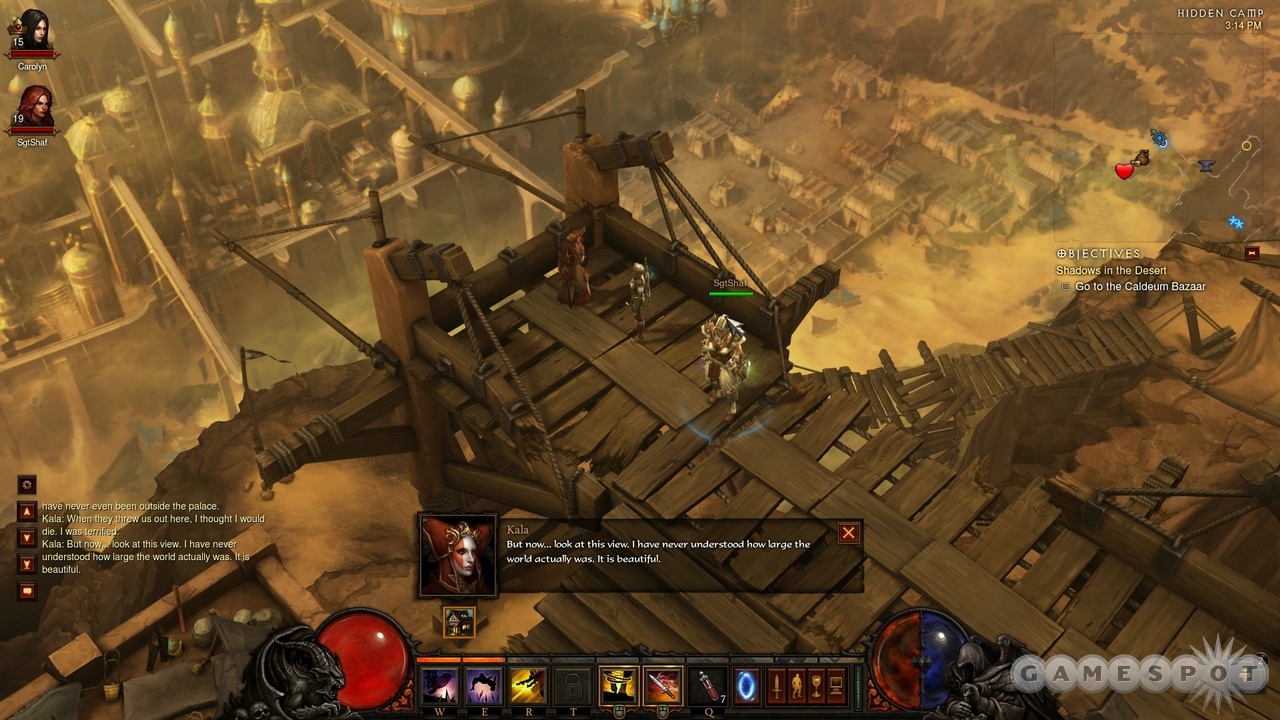
Without fail, you're rewarded for mowing down monsters with gold and gear. This is typical of the series and the genre, but it's handled here as well as it's ever been. You never feel like you're being showered with riches and items you haven't earned, nor that you're having to slog through too many foes to earn anything significant. Loot is doled out at a pace that makes your victories fulfilling and makes fighting the next group of foes lurking in the shadows ahead nigh irresistible.
The way your rewards emerge into the world is rewarding in itself; slay an elite monster, and coins and items pour onto the ground, making you feel like you've just won a jackpot in Vegas. Sometimes, the gear is junk so low in value that it's not even worth picking up. But you never know when you're going to stumble on a weapon or piece of armor that's superior to your current equipment, making you more capable of facing the coming hordes. Even if something isn't worth using, it's often worth grabbing, either to sell or to have it salvaged by the blacksmith in town for materials that can be used to craft other items.
Weapons function in Diablo III a bit oddly, though, and that may take some getting used to. Often, you may elect to have your primary skill be something that isn't weapon-based. You may choose the demon hunter's grenade attack, for instance, or the wizard's magic missile spell. Although these skills don't involve your characters actually using whatever weapons they're holding in their hands, the damage of your equipped weapon still comes into play. In other words, all other things being equal, a wizard's magic missile spell does more damage if she's holding a club that does 12 damage than if she's holding a dagger that does 10 damage. It's a system that makes more gear useful to more classes, but that usefulness comes at the expense of typical fantasy RPG logic.
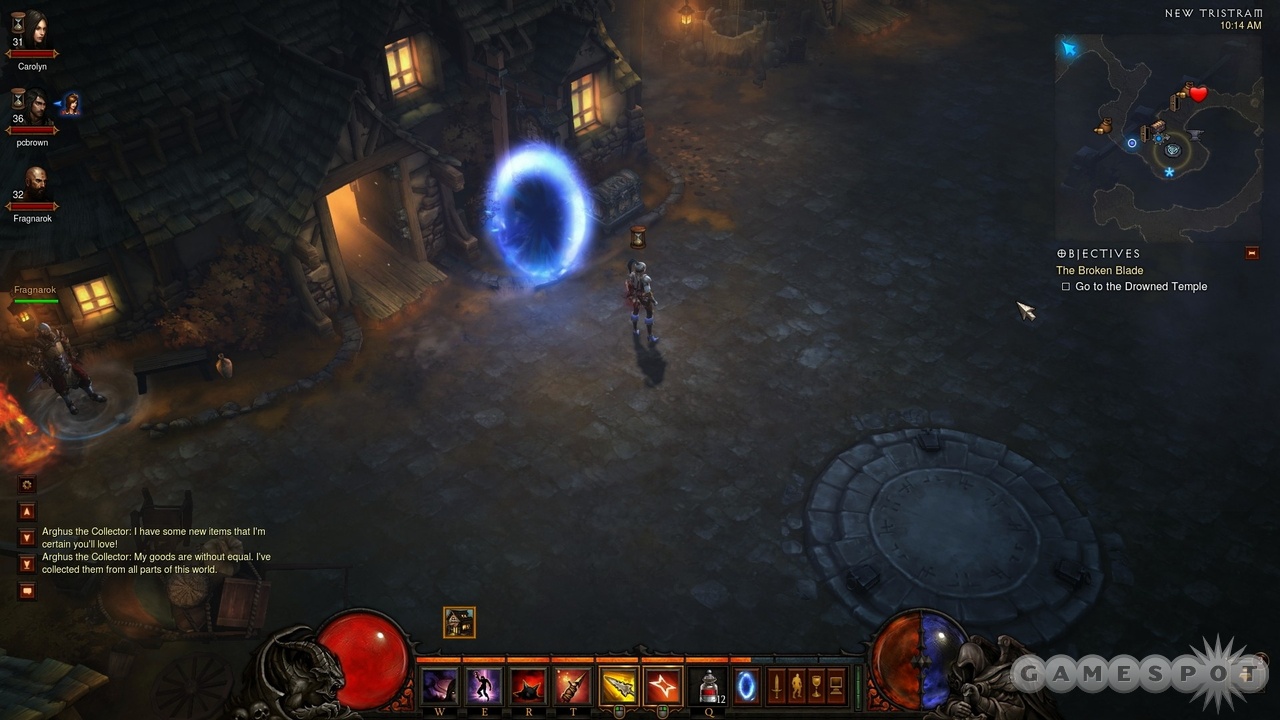
If you haven't yet found the perfect helm, boots, or crossbow for your character, you may opt to have the blacksmith craft you items. As with the stuff you find in the wild, the magic properties on gear he crafts are random, so there's often no guarantee that something he creates for you will suit you better than your current equipment, but odds are that sometimes he'll craft something that's ideal for you.
Unfortunately, you need to spend a good deal of gold on training him to level him up so that he can craft higher-level gear for you, and early on, it can feel as if you're sinking all your gold into this and reaping little reward. The rewards do come eventually, though, and all your characters in a given mode share the same craftsmen (the blacksmith and, later, a jeweler), so once the money is spent on training, you don't need to worry about spending it again.
The cycle of combat and loot and more combat is addictive, but without peril, it would eventually become unfulfilling. Thankfully, the hosts of hell become increasingly dangerous over time. Boss fights are numerous and frequent, and those that bring each act to a close can be challenging. They also offer more traditional action-game mechanics than the series has seen before. An early boss charges into walls, for example, leaving him stunned and giving you a chance to attack safely.
After you complete the game on the normal difficulty setting, you can continue on to nightmare, which is much more than just playing the same game again against more resilient foes. Nightmare changes things up by giving enemies powerful new abilities and placing challenging enemies in places where they didn't previously appear. Conquer nightmare and yet another, even more challenging difficulty becomes available. Whether you want a relatively easy, rewarding experience that you can pleasantly click your way through or an incredibly stiff challenge, Diablo III has what you're looking for. And for that added element of risk, you can play in Hardcore mode, where death is permanent.
Each class has the offensive capabilities to take on the forces of darkness alone, and the three AI companions you can choose from offer a helping hand and a sense of camaraderie to solo adventurers. But joining with up to three other players makes for a far more interesting dynamic. Freezing enemies in place when you're playing solo as a wizard is useful, but when doing so aids a team of players who are working together, it's much more fulfilling. Similarly, activating a mantra of healing as a monk just when your party is in dire need of a health boost is far more rewarding than just using this ability to save yourself.
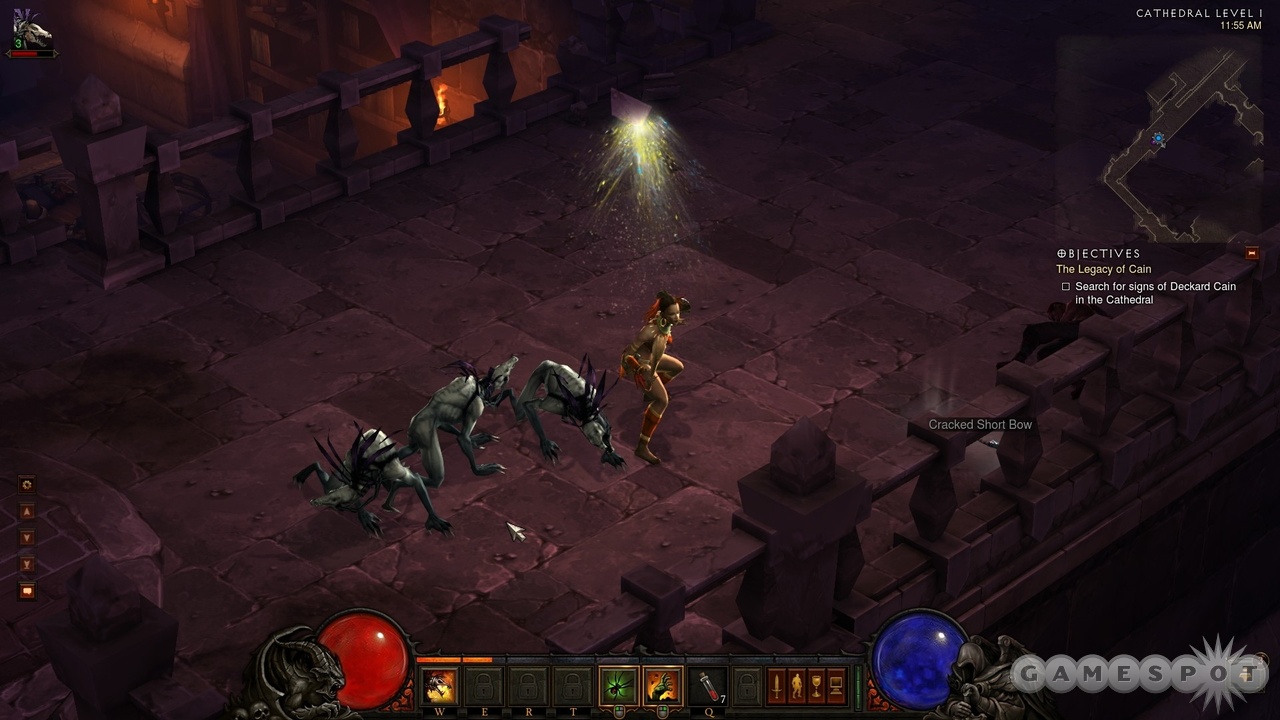
It's extremely easy to invite friends to your game or to jump into their games, or to text chat with friends who are going about their own adventures in their own realms. But be warned: as players join your game, the forces of evil become more powerful, and if you don't stay close to each other and work together, you might find that enemies who were previously pushovers are suddenly quite dangerous. This added challenge encourages teamwork; a friend who joins your game and then runs ahead to take on monsters alone is no friend at all. For all its focus on teaming up with friends, though, it's odd that Diablo III doesn't have built-in support for voice chat. Speaking to your friends to coordinate tactics on the fly is helpful, but you'll need to resort to third-party software in order to do it.
Unfortunately, though Diablo III often feels like a well-oiled machine of adventure and reward, it does occasionally sputter. You're required to be online at all times, even if you're playing solo, so if you don't have a reliable internet connection, you simply cannot play Diablo III. The servers go down periodically for maintenance, so you might find the game unavailable to play at times that you want to play it. Additionally, even when the game is up and running, you may experience the rare bout of knockback lag. When enemies and attacks fill the screen (as they often do), you may encounter some severe slowdown. And for all its refinement, there's the occasional rough edge to the action. The monk can teleport to enemies and attack them, for instance, but this effect is abrupt and jarring.

But these problems and frustrations are dwarfed by the pleasures Diablo III offers. There's a good chance you've played games a lot like Diablo III before, and at no point does it dare to surprise you by tinkering with its tried-and-true formula. But it creates such an enticing world and offers up such enjoyable abilities that it makes that formula feel fresh again. You may ultimately be victorious at vanquishing the forces of hell, but if their true mission is to give you a compelling reason to sacrifice sleep as you keep clicking your mouse into the wee hours of the night, then they have won a decisive victory.
